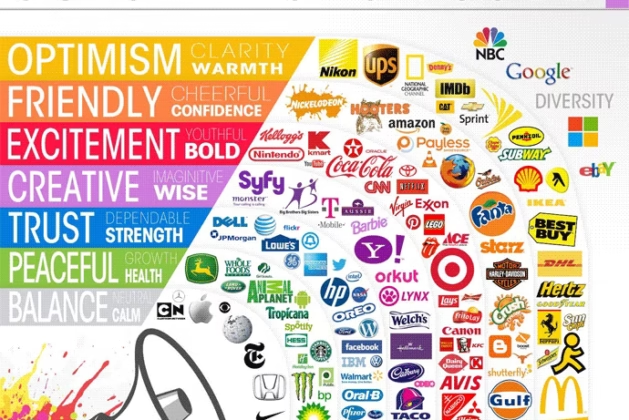Colors are more than just visual aesthetics—they evoke emotions, influence perceptions, and drive purchasing decisions. In the world of branding and marketing, understanding the psychology of color is essential for creating strong, impactful identities. This article explores the powerful role color plays in shaping consumer behavior and offers practical insights for marketers, designers, and business owners looking to leverage color to enhance their branding strategy.
Table of Contents
Why Colors Matter in Branding and Marketing
At its core, color has a significant impact on how we process and react to visual stimuli. Research shows that over 90% of first impressions are based on visual factors, with color being one of the most influential elements. In fact, studies have found that color increases brand recognition by 80% and can influence up to 85% of a consumer’s purchasing decision.
But what makes color so powerful? The answer lies in both biology and psychology. Our brains process color almost instantly, triggering emotional responses that can influence how we feel about a product or service. These feelings can be positive or negative, depending on the color. Brands use this to their advantage, associating certain colors with specific qualities like trust, luxury, or excitement.
The Psychology of Color in Branding
Let’s break down some of the most common colors used in branding and marketing, along with the emotions they tend to evoke and how businesses use them.
1. Red: Energy and Excitement
- Psychological Impact: Red is an intense, attention-grabbing color that stimulates excitement, passion, and urgency. It’s also linked to appetite, which is why many fast-food chains use red in their logos and packaging.
- Marketing Use: Red is perfect for brands that want to convey energy, excitement, or a sense of urgency. It’s commonly used in sales promotions or to grab attention in competitive industries.
- Brands: Coca-Cola, McDonald’s, and YouTube.
2. Blue: Trust and Professionalism
- Psychological Impact: Blue is often associated with calmness, trustworthiness, and security. It’s a color that makes people feel at ease and builds a sense of reliability.
- Marketing Use: Many tech companies, banks, and healthcare brands use blue to establish trust with their customers. It’s also a color that promotes productivity and is often used in corporate settings.
- Brands: Facebook, IBM, and American Express.
3. Yellow: Optimism and Attention
- Psychological Impact: Yellow is bright, cheerful, and full of energy. It stimulates happiness and optimism but can also cause feelings of caution if overused.
- Marketing Use: Yellow is a great color for brands that want to evoke warmth and positivity. It’s often used to catch the eye in advertising, especially in sales or promotions.
- Brands: IKEA, McDonald’s, and Best Buy.
4. Green: Nature and Health
- Psychological Impact: Green is deeply connected to nature, growth, and health. It evokes feelings of tranquility, renewal, and balance, making it an ideal color for wellness brands or eco-friendly businesses.
- Marketing Use: Brands in the organic food, environmental, or health sectors often use green to convey sustainability, organic quality, and health benefits.
- Brands: Starbucks, Whole Foods, and Tropicana.
5. Orange: Creativity and Fun
- Psychological Impact: Orange is vibrant and playful, promoting creativity, enthusiasm, and warmth. It’s an energizing color without the intensity of red.
- Marketing Use: Orange is used to inspire action, which is why it’s commonly used for calls to action (CTAs) on websites. It’s also great for brands targeting a younger, more dynamic audience.
- Brands: Fanta, Nickelodeon, and Amazon.
6. Purple: Luxury and Creativity
- Psychological Impact: Purple is traditionally associated with royalty, luxury, and elegance. It also symbolizes creativity and wisdom.
- Marketing Use: Purple is often used in high-end brands, especially those in the beauty, wellness, or luxury markets. It’s also a popular color in industries that want to convey a sense of mystery and innovation.
- Brands: Hallmark, Taco Bell, and Crown Royal.
7. Black: Sophistication and Power
- Psychological Impact: Black represents sophistication, authority, and elegance. It’s a color that exudes power and luxury, often used in high-end products.
- Marketing Use: Black is ideal for creating an exclusive, premium brand image. It’s used by many fashion and luxury brands to convey a sense of refinement and quality.
- Brands: Chanel, Nike, and Apple.
8. White: Simplicity and Cleanliness
- Psychological Impact: White evokes feelings of purity, cleanliness, and simplicity. It’s often used in minimalist designs to create a sense of space and clarity.
- Marketing Use: White is often used as a background color to allow other colors to pop. It’s also associated with simplicity, making it ideal for modern and high-tech brands.
- Brands: Apple, Tesla, and Coca-Cola.
How to Use Color Effectively in Your Marketing Strategy
1. Know Your Audience
When choosing colors for your brand, it’s essential to consider who you’re targeting. Different colors resonate with different demographics and cultures. For example, while blue is often associated with professionalism and trust, pink may be more appealing to a younger, female audience.
2. Create Emotional Connections
Think about the emotions you want your brand to evoke. Do you want your customers to feel excited? Comforted? Empowered? The color you choose should align with the emotions you want to trigger. For example, if you’re in the wellness industry, green is a natural choice to evoke feelings of health and balance.
3. Consistency is Key
Once you’ve chosen your brand colors, be consistent in their use across all marketing materials—your website, social media profiles, packaging, and advertisements. Consistency builds recognition and helps reinforce your brand’s identity.
4. Use Contrast to Stand Out
While it’s essential to use colors that align with your brand personality, don’t be afraid to incorporate contrasting colors to highlight specific elements. A well-placed call-to-action button, for example, can stand out more with a contrasting color, urging users to take action.
5. Test and Iterate
Color preferences can vary based on context, season, and trends. A color that works well today may not have the same impact tomorrow. Always test different color schemes and analyze customer feedback to see what resonates most with your audience.
Conclusion
The psychology of color in branding and marketing is a powerful force that can influence how consumers perceive your brand, what they feel about it, and ultimately, how they engage with it. By understanding the emotional and psychological effects of color, you can craft a more effective marketing strategy that resonates with your target audience and drives business results.
Remember, color is not just a design element—it’s a language of its own. Use it wisely, and it can become one of the most valuable tools in your branding arsenal.
Read More: DeepSeek: Unlocking the Hidden Web Beyond Search Engines





I loved as much as you will receive carried out right here The sketch is tasteful your authored subject matter stylish nonetheless you command get got an edginess over that you wish be delivering the following unwell unquestionably come further formerly again as exactly the same nearly very often inside case you shield this hike
Every time I visit your website, I’m greeted with thought-provoking content and impeccable writing. You truly have a gift for articulating complex ideas in a clear and engaging manner.
Its like you read my mind You appear to know so much about this like you wrote the book in it or something I think that you can do with a few pics to drive the message home a little bit but other than that this is fantastic blog A great read Ill certainly be back
Your blog is a constant source of inspiration for me. Your passion for your subject matter shines through in every post, and it’s clear that you genuinely care about making a positive impact on your readers.
Thank you for the auspicious writeup It in fact was a amusement account it Look advanced to more added agreeable from you By the way how could we communicate